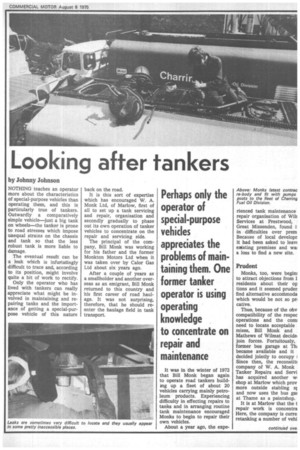Looking after tankers
Page 55

Page 56

If you've noticed an error in this article please click here to report it so we can fix it.
by Johnny Johnson
NOTHING teaches an operator more about the characteristics of special-purpose vehicles than operating them, and this is particularly true of tankers. Outwardly a comparatively simple vehicle—just a big tank on wheels—the tanker is prone to road stresses which impose unequal strains on the chassis and tank so that the less robust tank is more liable to damage.
The eventual result can be a leak which is infuriatingly difficult to trace and, according to its position, might involve quite a bit of work to rectify.
Only the operator who has lived with tankers can really appreciate what might be involved in maintaining and repairing tanks and the importance of getting a special-purpose vehicle of this nature back on the road.
It is this sort of expertise which has encouraged W. A. Monk Ltd, of Marlow, first of all to set up a tank servicing and repair, organisation and secondly gradually to phase out its own operation of tanker vehicles to concentrate on the repair and servicing side.
The principal of the company, Bill Monk was working for his father and the former Monkton Motors Ltd when it was taken over by Calor Gas Ltd about six years ago.
After a couple of years as a smallholder and another overseas as an emigrant, Bill Monk returned to this country and his first career of road haulage. It was not surprising, therefore, that he should reenter the haulage field in tank transport. It was in the winter of 1972 that Bill Monk began again to operate road tankers building up a fleet of about 20 vehicles carrying mainly petroleum products. Experiencing difficulty in effecting repairs to tanks and in arranging routine tank maintenance encouraged Monks to begin to repair their own vehicles.
About a year ago, the expe rienced tank maintenance repair organisation of Wilt Services at Prestwood, Great Missenden, found i in difficulties over prem Because of local develop', it had been asked to leavi existing premises and wa: a loss to find a new site.
Prudent
Monks, too, were 'begin] to attract objections from 1 residents about their op tions and it seemed pruden find alternative acconimoda which would be not so pri cative.
Thus, because of the obv compatibility of the respec operations and the C01111 need to locate acceptable mises, Bill Monk and Mathews of Wilmat decide' join forces. Fortuitously, former bus garage at Thi became available and it decided jointly to occupy 1 Since then, the reconstiti company of W. A. Monk Tanker Repairs and Servi has acquired another wi shop at Marlow which prov more outside stabling st and now uses the bus gai at Thame as a paintshop.
It is at Marlow that the t repair work is concentra Here, the company is curre retanking a number of vehi Charringtons used for iestic fuel and putting in !ps and power take-off its. However, the mainten3. and repair work and the el at which it is carried is the result of knowledge Led over the years.
lonks can refurbish metal ts of all descriptions ining light alloy tanks which perhaps, more prone than t to fracture and leakage.' company has no facilities leal with grp tanks, nding the leak is often e difficult than repairing it. tics do not use colour dyes rely on the knowledge and 3rtise of one of their fitstaff who is renowned for ability to trace the source leakages without artificial nce located, the leak can emedied quickly though the !d of repair depends largely he accessibility of the frac rdinarily, because they are re of the importance of ping special-purpose des on the road, Monks be able to effect the necesrepair while the driver ,s. In more difficult circurnces, perhaps because of the !ssity to remove the run; gear in order to gain ss to the faulty area, the cle might have to be deed overnight.
aturally, care has to be n that the tank is free from .mtnable or explosive mateand gas before repair work begin.
;assing
oaks usually submit the des presented to them for ntion to degassing by Calor which has its premises not sway. However, if the work e t undertaken immediately r the vehicle is returned to ks, then a further test has e done to ensure that gas not again built up inside tank in the intervening Dd. For this, the company an Explosimeter similar hat used in the mining inry to detect gases underind.
u s comprises a flexible !, one end of which is wed into the tank. By ns of a rubber bulb, a pie of the air/gas,. mixture ent in the tank is sucked the meter and gas content is measured on the graduated dial.
However, while the company specialises in tanker repairs it is quite capable of undertaking work on other types of specialised vehicles and does, in fact, quite a bit of work on car carriers.
Profitable
Mounting repair business is occupying the attention of the company almost to the exclusion of any other activity and, despite the original vehicle operation, it is on this side that efforts are being focused.
In any case, says Bill Monk, the repair business is now more profitable than the haulage business and soon this will cease altogether.




































































































